By Adrian Paul B. Conoza
Special Features Writer
Charting the path to recovery from the coronavirus disease 2019 (COVID-19) crisis involves planning ahead for underlying uncertainties and opportunities, the panelists of the recent session of BUSINESSWORLD INSIGHTS have concurred.
Starting off its second phase titled “Winning The Fight: COVID-19 Lessons”, BUSINESSWORLD INSIGHTS returned with the first of three sessions, discussing with industry experts across various sectors how working towards recovery from the pandemic should go beyond merely surviving.
The online forum was moderated by BusinessWorld‘s editor-in-chief Wilfredo Reyes, and was participated by Simon Wintels, partner at McKinsey and Company Singapore; Gary De Ocampo, president of Kantar Philippines, Inc.; Carl Winn Everhart, president and general manager of Coca-Cola Philippines; Nicky Gozon, director of Entrego Express Corporation; and Vincent Tempongko, vice president for site acquisition and management at Globe Telecom.
Reimagining in an uncertain future
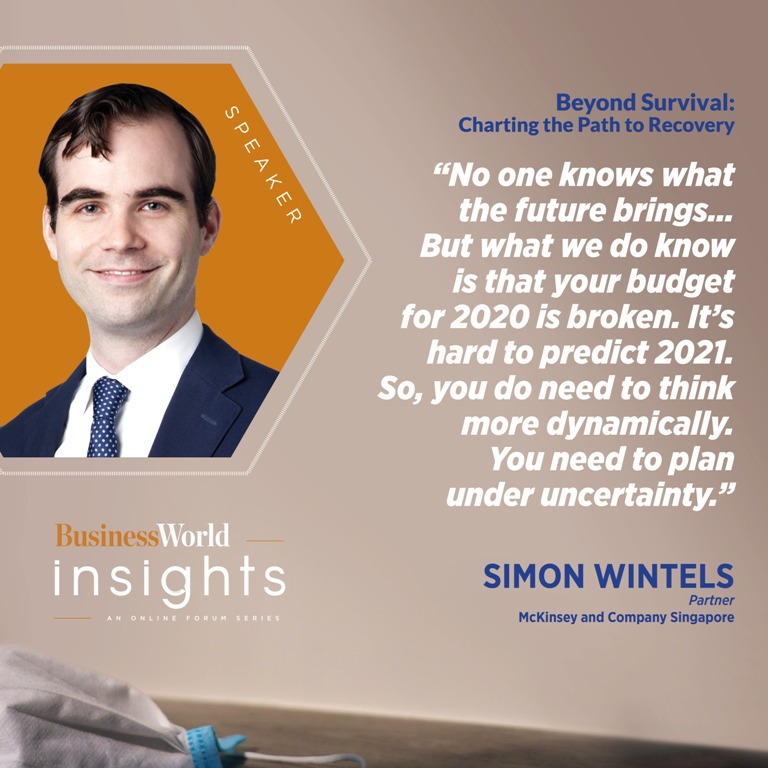 McKinsey’s Mr. Wintels, who leads its COVID-19 business team response for consumer goods companies across Asia, started off by noting that the crisis brings a due imperative of saving both lives and livelihoods.
McKinsey’s Mr. Wintels, who leads its COVID-19 business team response for consumer goods companies across Asia, started off by noting that the crisis brings a due imperative of saving both lives and livelihoods.
In managing the crisis, he added, most companies have managed to resolve and to be resilient, so the next steps they should take involve returning and reimagining what the new normal looks like.
Their research across Asia have shown significant changes across how consumers behave, according to the researcher.
These changes include the shift to at-home consumption; a shift to online shopping and food delivery; more emphasis on affordability; a drop in discretionary spending; choosing safe, healthy, and fresh items and shopping environments; and a shock to loyalty.
“Because of lockdowns, people have changed their primary stores for shopping, as well as changed their brands,” Mr. Wintels observed about the loyalty shift, which he finds to be temporary. “Filipinos have proven to be brand loyal, and most of them are going back to their primary brands after the lockdown ends.”
When asked how fast will consumers’ confidence bounce back, Mr. Wintels finds it will depend on two main drivers of gross domestic product growth or decline, namely the effectiveness of getting the virus under control and the impact of economic policy.
“If we look at the last 100 years of crisis, consumer uncertainty about what’s next is the real driver of consumer sentiment, and consumer sentiment is the real driver of consumption,” he added. “The faster an economy, a market, or a government is able to settle the uncertainty about what’s going to come…the quicker we can come back.”
The McKinsey partner also laid out a checklist that could guide businesses in planning ahead: re-engaging their customers, shoppers, consumers in a more digital facet; reimagining their offers and making them safer, healthier, and more affordable; keeping the agility of decision-making in a new operating model; and accelerating digital across the business.
Mr. Wintels also stressed that in stepping into recovery, the future remains uncertain, even with observed behavioral shifts that will either become permanent or will revert to what they were before.
“You do need to think more dynamically. You need to plan under uncertainty,” he advised, adding that the crisis makes it necessary to develop teams that will plan ahead and echo the point that every crisis is rich in opportunity.
Sending reassuring signals
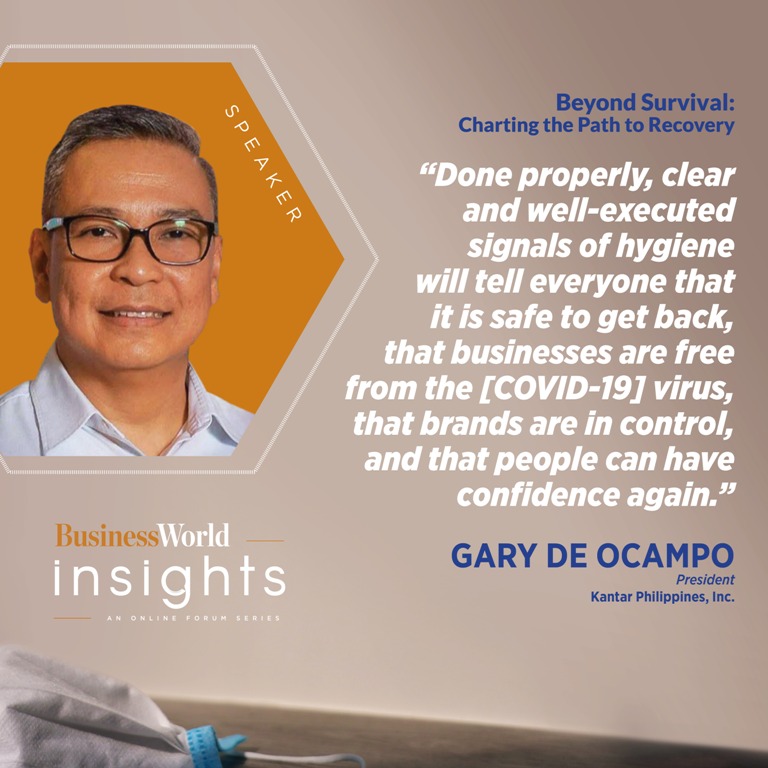 Mr. de Ocampo of Kantar Philippines shared the observations their firm has spotted from online Filipino adults during COVID-19. One of these is the heightened worry among Filipinos, which was seen to have been sustained despite getting accustomed to a certain extent to working and living from home.
Mr. de Ocampo of Kantar Philippines shared the observations their firm has spotted from online Filipino adults during COVID-19. One of these is the heightened worry among Filipinos, which was seen to have been sustained despite getting accustomed to a certain extent to working and living from home.
“The sustained anxiety is largely coming from expected long-term economic impacts, which would be exacerbated by the dreaded second wave,” he said.
In coping with the crisis, Mr. de Ocampo continued, Filipinos are stocking up on items such as food with long shelf-life, sanitizing items, vitamins, and supplements.
Filipino adults are also claiming to be eating healthier, he added, trying out new recipes, sleeping more, exercising more, and focusing on personal development.
Kantar Philippines’ findings also spotted an overall decline in purchase across all channels, albeit a third of online Filipino adults tried out e-commerce for the first time. Many are also found to be compelled to switch to buying in groceries near their homes or preferring deliveries.
In terms of viewing consumption, the findings further revealed, TV viewing has spiked. Moreover, the Philipines has posted the highest increase in the use of radio, Facebook, Messenger, and YouTube.
Regarding their plans in the future, Mr. de Ocampo added, respondents expressed their plans to decrease travel or commutes, while they give the highest consideration to making investments and subscribing to on-demand media and home broadband Internet.
While a great majority look forward to meeting friends and relatives and going back to houses of faith, he continued, Filipinos are set to make hard decisions between wanting to step out of their homes and needing to ensure their safety.
Relating these findings to how businesses can recover, Mr. de Ocampo finds that bringing back demand from consumers is the big task they have to tackle, and delivering unmistakable signals that tell consumers it is safe to enter the marketplace again unleashes this opportunity.
“Every business in every category must remake itself, then, in order to send the signals that will reactivate demand,” he said. “And it’s not just about advertising messages, but also about every aspect of the brand’s physical, digital, societal, and retail presence. It is about signaling reassurance in every possible way.”
In sending those right signals to activate demand, Mr. de Ocampo continued, businesses should focus on hygiene and self-sufficiency.
“Hygiene will impact any form of interaction and engagement. Everything people touch will have to offer assurance that it is sanitized well, because hygiene has become a life-saving tactic,” he said, noting that consumers are anxious for signals that show a brand’s commitment to protection.
“Done properly, clear and well-executed signals of hygiene will tell everyone that it is safe to get back, that businesses are free from the virus, that brands are in control, and that people can have confidence again,” he later added.
Mr. de Ocampo also stressed that readiness is set to be the new sign of success, noting that people will want to be ready and not caught in surprise again.
The Kantar Philippines president also emphasized the need for planning for multiple scenarios, which he said is the only thing individuals have control over. This kind of planning, he added, helps individuals and organizations become flexible.
Grounded on purpose, prioritizing people
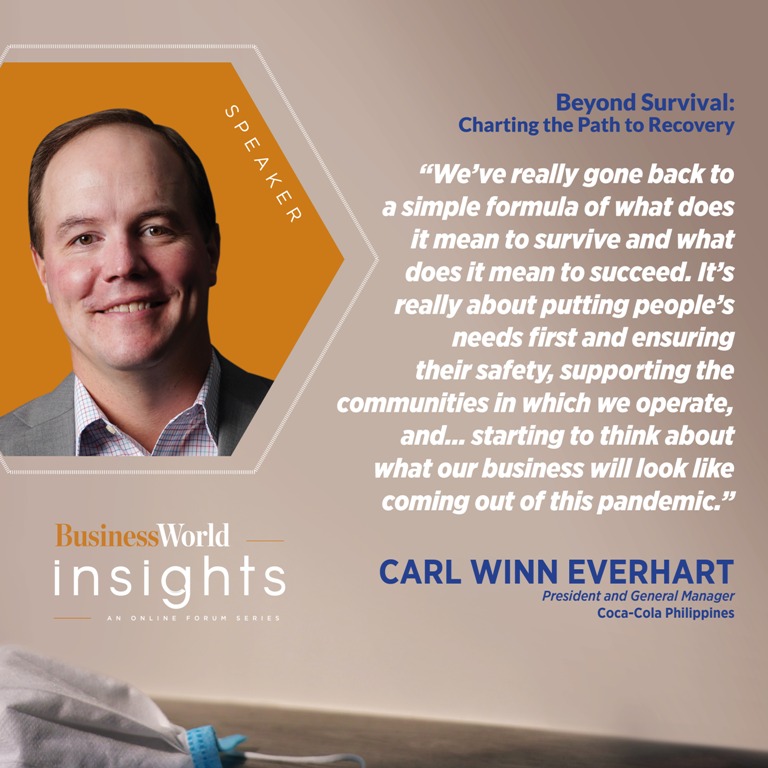 Mr. Everhart of Coca-Cola Philippines, meanwhile, shared how the company is paving their path to recovery as it intensively serves its purpose of refreshing the world and making a difference during this crisis.
Mr. Everhart of Coca-Cola Philippines, meanwhile, shared how the company is paving their path to recovery as it intensively serves its purpose of refreshing the world and making a difference during this crisis.
“As we think about the long history that we’ve had across the world and here in the Philippines, we’ve really gone back to a simple formula of what does it mean to survive and what does it mean to succeed,” he said. “It’s really about putting people’s needs first and ensuring their safety, supporting the communities in which we operate, and starting to think about what our business will look like coming out of this pandemic.”
The CEO shared that the company has been assuring that its workforce stays healthy, whether they work from home or at their factories, distribution plants, or trucks.
Believing that Coca-Cola is only as strong and as sustainable as the communities in which we serve, Mr. Everhart continued, the company has been assuring that its partners are also well-protected and empowered. In addition, he recalled the company’s shift in spending from advertising to helping communities in the country.
Furthermore, the CEO noted a recurrence in at-home consumption, having observed that consumers are venturing out less although they buy more.
Affordability is ringing very true with our customers, he added, as seen in consumers collecting larger size items. “For sure there is going to be huge affordability component within the Philippines that we should be mindful of,” he said.
Mr. Everhart also said Coca-Cola has definitely felt the decline amid the stable position in at-home consumption, as this is was not enough to offset the traffic decline in distribution to outdoor use such as restaurants and sporting events.
The CEO, nonetheless, remains optimistic about the company’s recovery as he sees a great opportunity for the company to emerge stronger by expanding its platforms, especially digital ones, in a rapidly changing landscape.
“Our belief is we’re going to be stronger based on the strategies we have in place today,” he said.
Opening a blank page for new beginnings
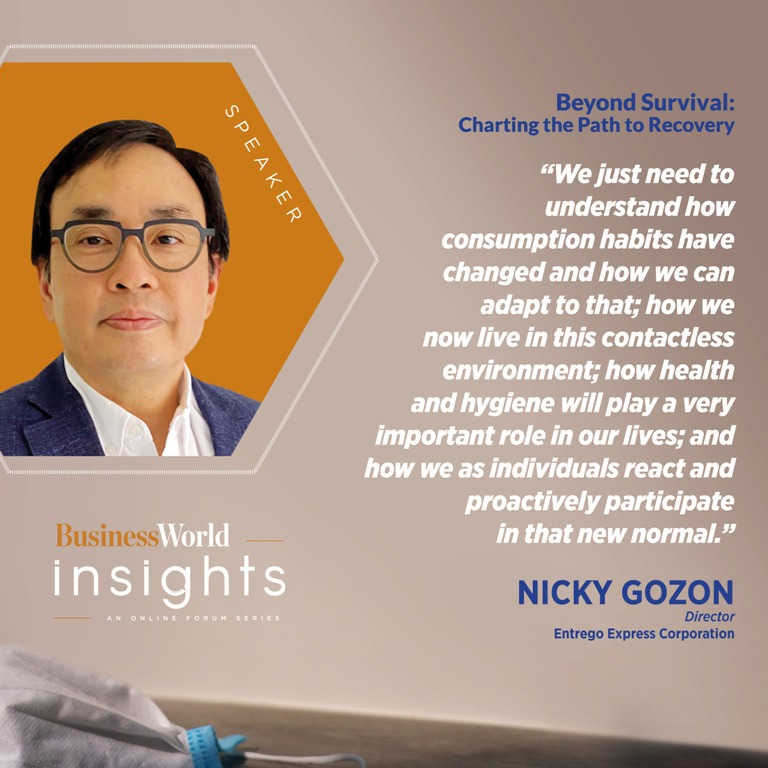 Understanding the current situation with other players is essential for Entrego’s Mr. Gozon, as the present crisis leaves one with no playbook on how to cope with the new normal.
Understanding the current situation with other players is essential for Entrego’s Mr. Gozon, as the present crisis leaves one with no playbook on how to cope with the new normal.
“We all have to help each other understand where we are. And, more importantly…we all have to be patient with each other,” he said. “We all have to understand that we ourselves are all trying to chart this new course in these new seas.”
“Understanding where we are will allow us to gauge and assess things we need to do to create our own reentry strategies into our own markets, [which will help] us build processes and make us more resilient after we have reentered the market and [will] allow us to transform and build our business and adapt to this new normal,” he added.
For Mr. Gozon, the logistics company is an enabler in the new normal as it serves as the ‘hands and legs’ of businesses, bringing goods to customers and allowing customers to be engaged with them even in a contact-less environment.
“We started delivering essentials even at the height of the lockdown because logistics plays a very important role in ensuring that the links of the supply chain are not broken,” he added.
Mr. Gozon also stressed that as businesses go into the new normal, they have to make sure that employees will feel confident re-entering the market. “At the end of the day, the success of any endeavor in any business will require the employees’ support,” he noted.
Citing trend forecaster Li Edelkoort, Mr. Gozon also finds the COVID-19 offering “a blank page for new beginnings”, and so he encourages businesses to become resilient, adaptive, and more prepared.
“We need to understand how consumption habits have changed and how we can adapt to that, how we now live in this contactless environment, how health and hygiene will play a very important role in all our lives moving forward, and how we as individuals react and proactively participate in that new normal,” he said.
Pressing demand for connectivity
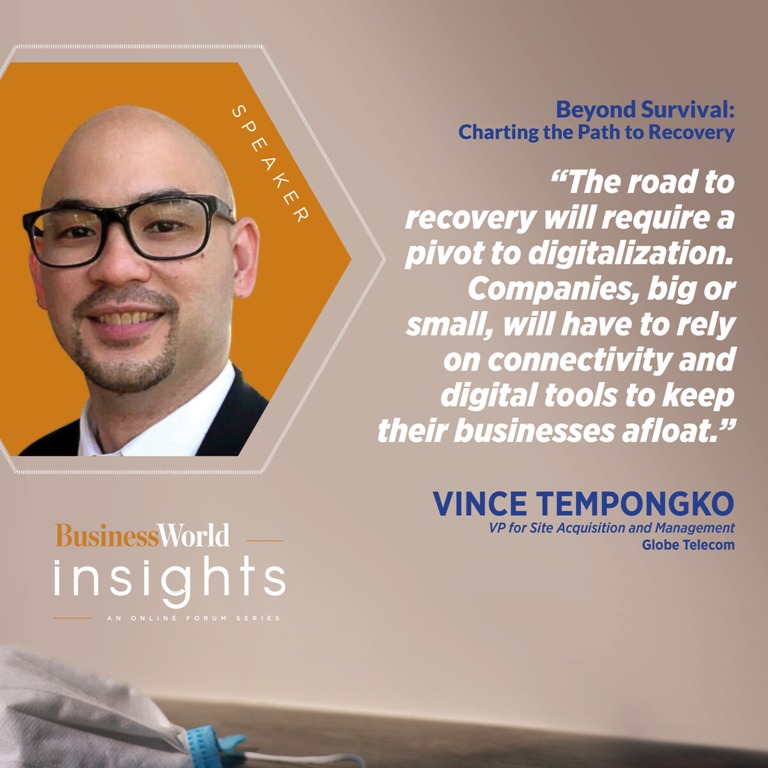 Connectivity has become a top priority as it is essential to keep people’s lives and businesses going during the community quarantine, according to Mr. Tempongko of Globe.
Connectivity has become a top priority as it is essential to keep people’s lives and businesses going during the community quarantine, according to Mr. Tempongko of Globe.
With a sudden shift from physical to digital interactions and transactions evident across different sectors, he continued, pivoting to digitalization is necessary to keep companies of all sizes afloat.
“Business recovery through digitalization demands better connection, better service, and better experience,” he said.
Mr. Tempongko added that business players should be able to identify key business processes and enter reactions that can be enabled and streamlined digitally so that they can be capable to run their businesses remotely and reach out to their customers even with limited physical interaction.
Moreover, the Globe executive shared that Globe has been enhancing its customer experience through digital means, while it has been empowering the local economy by providing appropriate technologies, infrastructure, and solutions.
Globe has been aggressively investing in and expanding its network, Mr. Tempongko added. He sees a challenge, however, in the permitting processes of local government units (LGUs) which he finds are tedious and slow.
“The Philippines suffers from having low site density compared to other countries due to lack of cell sites in relation to the number of Internet users,” he noted.
He expressed optimism over some LGUs who have started working towards the digitalization of their communities which eventually allows Globe to build its infrastructure in those areas, while he also remains hopeful that other LGUs will realize the need for ICT and network facilities in this new reality.
“We also appeal to our consumers and the communities to accept and allow our facilities as we need these facilities as near as possible to the consumers, so that we can enjoy better and faster Internet,” he added.
Upcoming BUSINESSWORLD INSIGHTS sessions will discuss “Improving the Country’s Healthcare and Welfare System” on June 3; and “Focusing on the Value of the Labor Market and MSMEs” on June 10. The sessions can be viewed on the Facebook pages of BusinessWorld and The Philippine STAR
BUSINESSWORLDINSIGHTS Phase 2 is made possible by SM, Globe, Entrego, Unilab, The Philippine STAR and Olern with the support of Management Association of the Philippines, Philippine Chamber of Commerce and Industry, Philippine Association of National Advertisers, Bank Marketing Association of the Philippines and CFA Society Philippines.


 McKinsey’s Mr. Wintels, who leads its COVID-19 business team response for consumer goods companies across Asia, started off by noting that the crisis brings a due imperative of saving both lives and livelihoods.
McKinsey’s Mr. Wintels, who leads its COVID-19 business team response for consumer goods companies across Asia, started off by noting that the crisis brings a due imperative of saving both lives and livelihoods. Mr. de Ocampo of Kantar Philippines shared the observations their firm has spotted from online Filipino adults during COVID-19. One of these is the heightened worry among Filipinos, which was seen to have been sustained despite getting accustomed to a certain extent to working and living from home.
Mr. de Ocampo of Kantar Philippines shared the observations their firm has spotted from online Filipino adults during COVID-19. One of these is the heightened worry among Filipinos, which was seen to have been sustained despite getting accustomed to a certain extent to working and living from home. Mr. Everhart of Coca-Cola Philippines, meanwhile, shared how the company is paving their path to recovery as it intensively serves its purpose of refreshing the world and making a difference during this crisis.
Mr. Everhart of Coca-Cola Philippines, meanwhile, shared how the company is paving their path to recovery as it intensively serves its purpose of refreshing the world and making a difference during this crisis. Understanding the current situation with other players is essential for Entrego’s Mr. Gozon, as the present crisis leaves one with no playbook on how to cope with the new normal.
Understanding the current situation with other players is essential for Entrego’s Mr. Gozon, as the present crisis leaves one with no playbook on how to cope with the new normal. Connectivity has become a top priority as it is essential to keep people’s lives and businesses going during the community quarantine, according to Mr. Tempongko of Globe.
Connectivity has become a top priority as it is essential to keep people’s lives and businesses going during the community quarantine, according to Mr. Tempongko of Globe.
